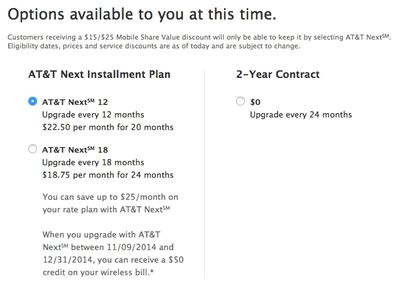AT&T is now offering a $50 bill credit to customers who purchase a new iPhone from the Apple Online or Apple Retail Stores. Neither company has marketed the deal but an AT&T spokesperson confirmed the existence of the promotion to MacRumors. The purchase and financing of any iPhone model that Apple sells, including the 5c, 5s, 6 and 6 Plus, qualifies the buyer for the credit.
The $50 credit promotion, which runs through the end of the year, does have a number of requirements which should be easily met for most existing AT&T customers:
- The iPhone must be purchased on an existing line as an upgrade.
- The iPhone must be financed on an AT&T Next installment plan.
- The iPhone must remain active and in good standing on Next for 45 days.
$50 Bill Credit Offer: Ends 12/31/14. Must remain in active and in good standing on Next for 45 days to receive bill credit on your AT&T mobility bill within 3 bill cycles. Upgrades only. Requires iPhone to be purchased via AT&T NextSM and activated on a qualifying AT&T voice and data wireless service plan. Offer may not be combinable with other credits, discounts and offers. Offer and terms subject to change and may be discontinued at any time without notice.

Customers looking for an unlocked phone should wait for the bill credit to be applied to their account before paying off the AT&T Next financing and unlocking their phone through AT&T's unlocking process.
The promotion launched earlier this week and is scheduled to run through December 31st, but the fine print notes that AT&T can discontinue it at any time.
























Top Rated Comments
Exactly.
Next is an interest and fee free loan.
Couldn't be more incorrect. More ignorance peddling totally incorrect information.
128gb iPhone 6 full retail is $849.
On AT&T next it's $35.38/month for 24 months = $849.12
Not sure where Next is a bad deal?
YOU may not be able to upgrade your Next plan because you already ordered a phone, but for anyone eligible, they can use Next to buy a phone on Apple's website.
You mean like how AT&T Next works, where the consumer pays for the whole device?
Read the FAQ found on the link you posted and educate yourself.